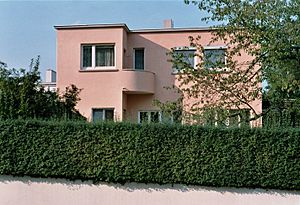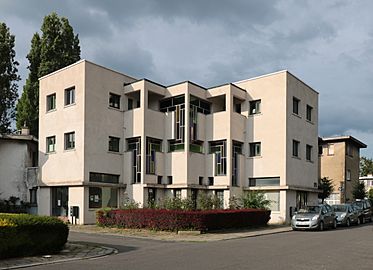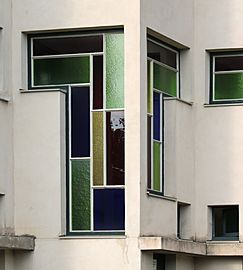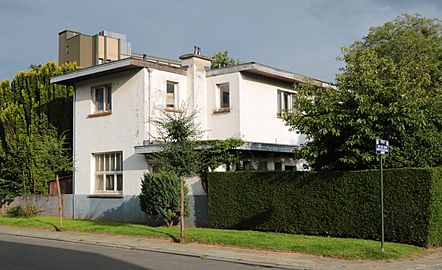Victor Bourgeois facts for kids
Victor Bourgeois (born August 29, 1897 – died July 24, 1962) was a famous Belgian architect and city planner. Many people consider him the most important Belgian architect of the modern style.
Victor Bourgeois was born in Charleroi. He studied architecture at the Royal Academy of Fine Arts in Brussels from 1914 to 1918. A well-known artist named Henry van de Velde was his mentor. Victor and his brother Pierre Bourgeois also started several magazines, including 7 Arts (published from 1922 to 1928).
In 1927, Victor Bourgeois was the only Belgian architect asked to design a house. This house was for a special exhibition called the Weissenhof Estate in Stuttgart, Germany. The next year, he helped start an important group called the International Congress of Modern Architecture. He was also a delegate at their first meeting. Victor Bourgeois passed away in Ixelles in 1962.
Contents
Designing the Cité Moderne
Victor Bourgeois's first major architecture project was a group of houses in Koekelberg, Brussels. These houses showed the clear influence of Dutch modern architects. His biggest project was built between 1922 and 1925 in Sint-Agatha-Berchem, Brussels. This project was called the Cité Moderne (Modern City).
A New Way to Live
The Cité Moderne was built for a group that helped provide affordable homes. It included 275 homes, all designed to be low-cost. Each home faced the sun and had its own private garden. The buildings were made using reinforced concrete, which was a new and experimental building method back then.
The houses and small apartment buildings had a very simple, clean style. They were white with colored details, sharp right angles, and flat roofs. This was an early example of the modernist style in architecture.
Planning for Community
The entire Cité Moderne area was planned by city planner Louis Van der Swaelmen. He wanted the design to encourage people to live together and support each other. He also planned it to be a safe place for everyone. The names of the streets and squares show these ideas, like Foundation Street and Evolution Street.
This project won Victor Bourgeois a Grand Prize at the International Exhibition of Modern Decorative and Industrial Arts in 1925. This award helped him become known around the world. Today, the Cité Moderne needs some repairs, but it remains an important example of early modern architecture.
- Cité Moderne (Sint-Agatha-Berchem)
Key Architectural Projects
Victor Bourgeois designed many important buildings throughout his career. Here are some of his notable works:
- Apartment building in Koekelberg, 1922
- Cité Moderne in Sint-Agatha-Berchem, 1922–1925
- House for the Weissenhof Estate exhibition in Stuttgart, 1927
- House and studio for sculptor Oscar Jespers in Brussels, 1928
- Apartment buildings in Brussels, 1935
- Buildings for the Brussels International Exposition (Grand Palace, Leopold II Restaurant, Soprocol Pavilion), 1935
- Villa Le Jeannerie in Sint-Genesius-Rode, 1936
- House Eliat in Brussels, 1938
- Belgian Pavilion at the New York World's Fair (with Henry van de Velde and Léon Stynen), 1939
- Post Office Accounts Office in Brussels, 1937–1949
- Town Hall in Ostend, 1954-1960
- Town Hall in Nivelles, 1954
- Eternit Tower and Germinal Pavilion at the Expo 58 in Brussels, 1958
See also
 In Spanish: Victor Bourgeois para niños
In Spanish: Victor Bourgeois para niños





